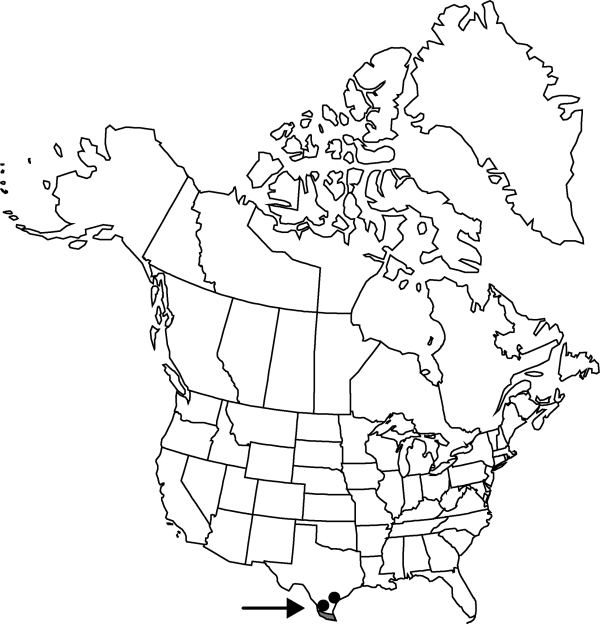Difference between revisions of "Echinocereus berlandieri"
Cact.-Verz., 19. 1859.
FNA>Volume Importer |
imported>Volume Importer |
||
| (6 intermediate revisions by 2 users not shown) | |||
| Line 8: | Line 8: | ||
}} | }} | ||
|common_names=Berlandier’s hedgehog cactus | |common_names=Berlandier’s hedgehog cactus | ||
| − | |basionyms={{Treatment/ID/ | + | |basionyms={{Treatment/ID/Basionym |
|name=Cereus berlandieri | |name=Cereus berlandieri | ||
|authority=Engelm ann | |authority=Engelm ann | ||
| + | |rank=species | ||
| + | |publication_title=Proc. Amer. Acad. Arts | ||
| + | |publication_place=3: 286. 1856 | ||
}} | }} | ||
|synonyms= | |synonyms= | ||
| Line 27: | Line 30: | ||
|elevation=0-100[-600] m | |elevation=0-100[-600] m | ||
|distribution=Tex.;Mexico (Tamaulipas). | |distribution=Tex.;Mexico (Tamaulipas). | ||
| − | |discussion=<p>Echinocereus berlandieri was originally discovered along the Nueces River, presumably the mouth of the river near Corpus Christi, and has not been seen there since. It has been rarely documented also from the lower Rio Grande Valley. Published records from elsewhere are all based on misidentified material of E. pentalophus, E. papillosus, E. enneacanthus var. brevispinus, and (in Mexico) E. cinerascens (de Candolle) Haage var. tulensis (Bravo) N. P. Taylor. Like E. pentalophus from the same region, E. berlandieri has often been misidentified as E. blanckii (Poselger) Palmer, a Mexican species. Furthermore, D. Weniger (1970) misapplied the name E. berlandieri to part of the common and variable E. pentalophus.</p> | + | |discussion=<p><i>Echinocereus berlandieri</i> was originally discovered along the Nueces River, presumably the mouth of the river near Corpus Christi, and has not been seen there since. It has been rarely documented also from the lower Rio Grande Valley. Published records from elsewhere are all based on misidentified material of <i>E. pentalophus</i>, <i>E. papillosus</i>, <i>E. enneacanthus </i>var.<i> brevispinus</i>, and (in Mexico) <i>E. cinerascens</i> (de Candolle) Haage var. tulensis (Bravo) N. P. Taylor. Like <i>E. pentalophus</i> from the same region, <i>E. berlandieri</i> has often been misidentified as E. blanckii (Poselger) Palmer, a Mexican species. Furthermore, D. Weniger (1970) misapplied the name <i>E. berlandieri</i> to part of the common and variable <i>E. pentalophus</i>.</p> |
|tables= | |tables= | ||
|references= | |references= | ||
| Line 36: | Line 39: | ||
-->{{#Taxon: | -->{{#Taxon: | ||
name=Echinocereus berlandieri | name=Echinocereus berlandieri | ||
| − | |||
|authority=(Engelmann) Haage | |authority=(Engelmann) Haage | ||
|rank=species | |rank=species | ||
| Line 51: | Line 53: | ||
|publication year=1859 | |publication year=1859 | ||
|special status= | |special status= | ||
| − | |source xml=https:// | + | |source xml=https://bitbucket.org/aafc-mbb/fna-data-curation/src/2e0870ddd59836b60bcf96646a41e87ea5a5943a/coarse_grained_fna_xml/V4/V4_326.xml |
|subfamily=Cactaceae subfam. Cactoideae | |subfamily=Cactaceae subfam. Cactoideae | ||
|genus=Echinocereus | |genus=Echinocereus | ||
Latest revision as of 21:57, 5 November 2020
Plants branched, sprawling, clones to 3 m or more wide. Stems soon decumbent, cylindric, (10–)20–36 × 1.5–3 cm; ribs 5–7, crests undulate; areoles 10–15 mm apart. Spines 9–10 per areole, straight, stiff, white, tipped dark; radial spines 6–9 per areole, appressed-spreading, to 10 mm; central spines 1–3 per areole, projecting outward, to 30 mm. Flowers 5–6 × 0.2–4.8 cm; flower tube 10–20 × 10–30 mm; flower tube hairs short, inconspicuous; inner tepals purplish pink or magenta, often with darker midstripes and/or proximal region, 40 × 18 mm, tips relatively thin and delicate; anthers yellow; nectar chamber 4–6 mm. Fruits olive green to 25 mm, pulp white or colorless. 2n = 22.
Phenology: Flowering May–Jun; fruiting 2-3 months after flowering.
Habitat: Shady thickets, coastal plain
Elevation: 0-100[-600] m
Distribution

Tex., Mexico (Tamaulipas).
Discussion
Echinocereus berlandieri was originally discovered along the Nueces River, presumably the mouth of the river near Corpus Christi, and has not been seen there since. It has been rarely documented also from the lower Rio Grande Valley. Published records from elsewhere are all based on misidentified material of E. pentalophus, E. papillosus, E. enneacanthus var. brevispinus, and (in Mexico) E. cinerascens (de Candolle) Haage var. tulensis (Bravo) N. P. Taylor. Like E. pentalophus from the same region, E. berlandieri has often been misidentified as E. blanckii (Poselger) Palmer, a Mexican species. Furthermore, D. Weniger (1970) misapplied the name E. berlandieri to part of the common and variable E. pentalophus.
Selected References
None.